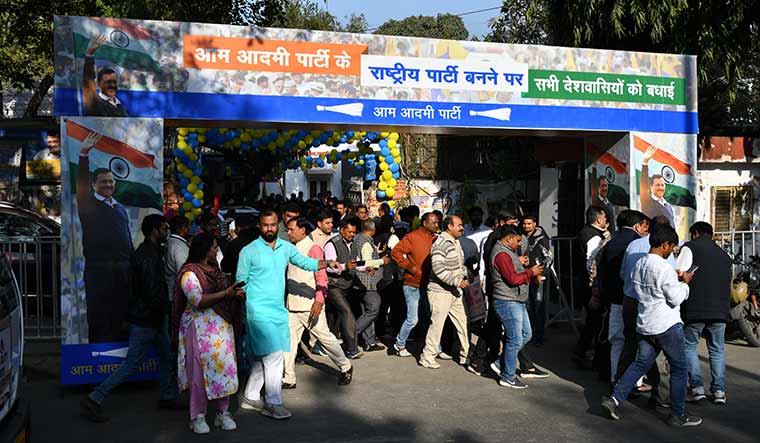FROM GROUND ZERO to the home turf of the leader of the party it seeks to challenge―for the Aam Aadmi Party and Arvind Kejriwal, the electoral takeaways from the civic polls in Delhi and the assembly elections in Gujarat hold immense significance.
Just a day after the AAP dislodged the BJP from the municipal corporation of Delhi, ending a three-term rule of the saffron party, it got reasons to celebrate in Gujarat, too, winning five seats and around 13 per cent votes, a performance that will enable it to officially be in the big league and be called a national party.
The scale of the victory in the MCD polls was not as good as one the party would have liked. And in Gujarat, it fell short of its goal of emerging as number two. However, the positives clearly outweigh the disappointments.
AAP leaders say the gambit to enter the fray in Gujarat, which had always seen a bipolar contest and looked like the impenetrable fortress of the BJP, has paid off. The AAP, they say, turned the contest into a triangular one, and the next step would be to replace the Congress as the main opposition and then win the state. Also, by challenging Modi in his home state, Kejriwal made clear his intention to be seen as his potential challenger at the national level, which is significant with just about a year left for the Lok Sabha polls.
“We could not win Gujarat, but we displayed our gumption to challenge Prime Minister Narendra Modi and the BJP in their fortress. Considering that, what we have achieved is no mean feat,” said senior AAP leader and Rajya Sabha member Sanjay Singh.
The 13 per cent vote share in Gujarat is something that comes as a boost to the AAP’s expansion plans and national ambitions. “To become a national party in just 10 years shows that the future belongs to politics of honesty, education and health care, something that the AAP stands for,” said senior AAP leader Durgesh Pathak.
Also read
- Gujarat: Modi mantra of good governance infused with hindutva pays rich dividends
- Modi magic dispels all obstacles to win Gujarat in style
- What led to Congress's decimation in Gujarat
- What can Congress learn from Gujarat loss and Himachal win
- Himachal: 10 guarantees Congress gave to the voter that helped it win
- Exclusive: "We will bring honesty and transparency in Himachal Pradesh", says Sukhu
As the AAP realised that its endeavour to connect with the people of Himachal Pradesh was not getting the expected response, it quietly and quickly withdrew from the scene and focused on the Gujarat and MCD polls. The party’s expansion plans are linked to replacing a weakening Congress. While the Congress continued to be a viable alternative for the people in Himachal Pradesh, in Gujarat, the AAP sensed that its campaign would have a greater impact.
The AAP’s assessment is that its performance will help boost its narrative of a small party taking on a behemoth like the BJP and getting the better of it. The idea it seeks to convey is that only the AAP can counter the BJP and provide an alternative. Both in the MCD polls and in Gujarat, the AAP gained at the cost of the Congress while the BJP held on to its support base.
With its narrative that focuses on the Delhi model of governance that comprises elements such as free electricity and water and quality health care and education, the AAP will forcefully stake its claims to the high table of politics and openly challenge the Congress as the principal opposition party.


